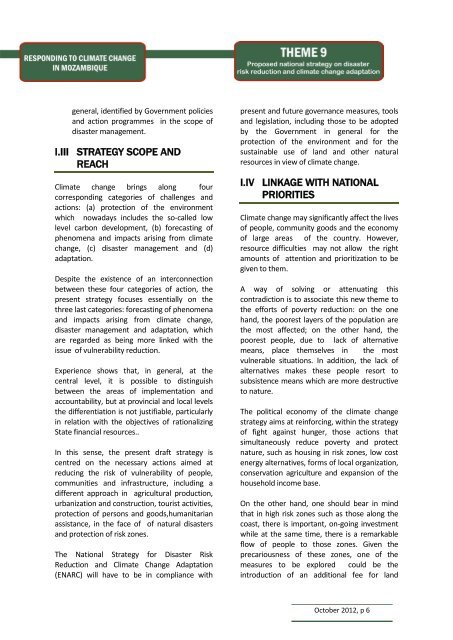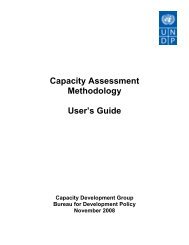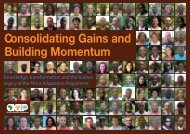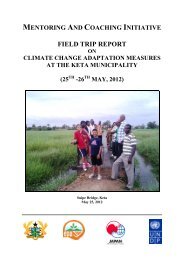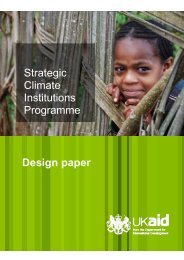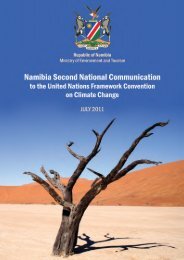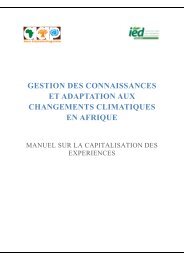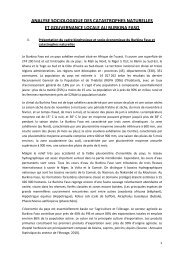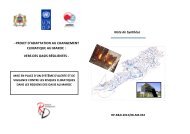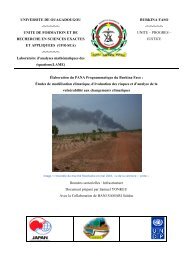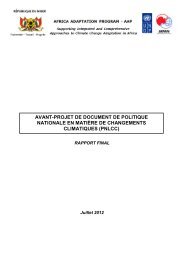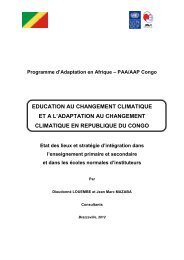Theme 9 Strategy ENG.pdf - Africa Adaptation Programme
Theme 9 Strategy ENG.pdf - Africa Adaptation Programme
Theme 9 Strategy ENG.pdf - Africa Adaptation Programme
- No tags were found...
You also want an ePaper? Increase the reach of your titles
YUMPU automatically turns print PDFs into web optimized ePapers that Google loves.
general, identified by Government policiesand action programmes in the scope ofdisaster management.I.III STRATEGY SCOPE ANDREACHClimate change brings along fourcorresponding categories of challenges andactions: (a) protection of the environmentwhich nowadays includes the so-called lowlevel carbon development, (b) forecasting ofphenomena and impacts arising from climatechange, (c) disaster management and (d)adaptation.Despite the existence of an interconnectionbetween these four categories of action, thepresent strategy focuses essentially on thethree last categories: forecasting of phenomenaand impacts arising from climate change,disaster management and adaptation, whichare regarded as being more linked with theissue of vulnerability reduction.Experience shows that, in general, at thecentral level, it is possible to distinguishbetween the areas of implementation andaccountability, but at provincial and local levelsthe differentiation is not justifiable, particularlyin relation with the objectives of rationalizingState financial resources..In this sense, the present draft strategy iscentred on the necessary actions aimed atreducing the risk of vulnerability of people,communities and infrastructure, including adifferent approach in agricultural production,urbanization and construction, tourist activities,protection of persons and goods,humanitarianassistance, in the face of of natural disastersand protection of risk zones.The National <strong>Strategy</strong> for Disaster RiskReduction and Climate Change <strong>Adaptation</strong>(ENARC) will have to be in compliance withpresent and future governance measures, toolsand legislation, including those to be adoptedby the Government in general for theprotection of the environment and for thesustainable use of land and other naturalresources in view of climate change.I.IV LINKAGE WITH NATIONALPRIORITIESClimate change may significantly affect the livesof people, community goods and the economyof large areas of the country. However,resource difficulties may not allow the rightamounts of attention and prioritization to begiven to them.A way of solving or attenuating thiscontradiction is to associate this new theme tothe efforts of poverty reduction: on the onehand, the poorest layers of the population arethe most affected; on the other hand, thepoorest people, due to lack of alternativemeans, place themselves in the mostvulnerable situations. In addition, the lack ofalternatives makes these people resort tosubsistence means which are more destructiveto nature.The political economy of the climate changestrategy aims at reinforcing, within the strategyof fight against hunger, those actions thatsimultaneously reduce poverty and protectnature, such as housing in risk zones, low costenergy alternatives, forms of local organization,conservation agriculture and expansion of thehousehold income base.On the other hand, one should bear in mindthat in high risk zones such as those along thecoast, there is important, on-going investmentwhile at the same time, there is a remarkableflow of people to those zones. Given theprecariousness of these zones, one of themeasures to be explored could be theintroduction of an additional fee for landOctober 2012, p 6


